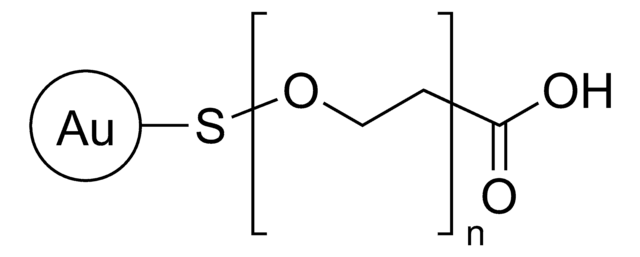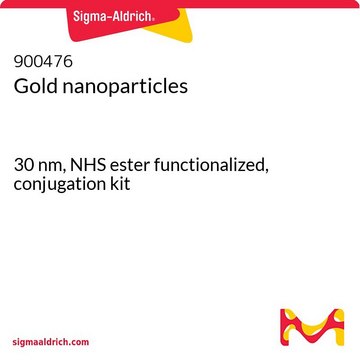765554
Gold nanoparticles
40 nm diameter, carboxylic acid functionalized, PEG 3000 coated, OD 50, dispersion in H2O
Sinonimo/i:
Gold nanoparticles COOH functionalized, Au NP COOH, Gold Colloid
About This Item
Prodotti consigliati
Materiali
PEG 3000
Forma fisica
dispersion in H2O
nanoparticles
Confezionamento
poly bottle of 1 mL
OD
50
Diametro
40 nm
pH
6.0-8.0 (25 °C)
Solubilità
water: miscible
Densità
1.00 g/cm3
λmax
530 nm
Gruppo funzionale
carboxylic acid
Temperatura di conservazione
2-8°C
Cerchi prodotti simili? Visita Guida al confronto tra prodotti
Descrizione generale
Applicazioni
- Since they adhere to cell membranes, AuNPs may find use in cellular and intracellular targeting in targeted drug delivery applications and may also be used in biodistribution studies.
- AuNPs may also be used in photothermal therapy and radiotherapy.
- AuNPs ranging from 10 to 250 nm, were studied to have been absorbed primarily by liver and spleen, when injected intravenously in rats.Whereas, 10 nm nanoparticles were distributed more broadly into various organs.
- Carboxylic acid end-groups bind with various proteins and hence are used in targeted drug delivery and gene therapy.
Caratteristiche e vantaggi
Codice della classe di stoccaggio
12 - Non Combustible Liquids
Classe di pericolosità dell'acqua (WGK)
WGK 1
Punto d’infiammabilità (°F)
Not applicable
Punto d’infiammabilità (°C)
Not applicable
Certificati d'analisi (COA)
Cerca il Certificati d'analisi (COA) digitando il numero di lotto/batch corrispondente. I numeri di lotto o di batch sono stampati sull'etichetta dei prodotti dopo la parola ‘Lotto’ o ‘Batch’.
Possiedi già questo prodotto?
I documenti relativi ai prodotti acquistati recentemente sono disponibili nell’Archivio dei documenti.
Articoli
The recent emergence of a number of highly functional nanomaterials has enabled new approaches to the understanding, diagnosis, and treatment of cancer.
Biomaterials science involves the design and fabrication of smart materials for studying, directing, or mimicking biology. For successful integration of biomaterials in biological research, a meaningful understanding of biological systems is required.
Il team dei nostri ricercatori vanta grande esperienza in tutte le aree della ricerca quali Life Science, scienza dei materiali, sintesi chimica, cromatografia, discipline analitiche, ecc..
Contatta l'Assistenza Tecnica.




